Workplace Safety Screenings is wrapping up a three-part series on workplace safety. We have discussed the when and the why, but we would be remiss if we didn’t tell you how you can accomplish an improved safety rating that leads to a worthwhile return on investment.
Just like with every other endeavor in life, you need to start at the beginning. From the start, you want to make sure you are hiring employees who can be trusted with on-the-job safety. That means implementing a pre screening program that checks on the integrity of a potential employee from all angles. This not only helps weed out employees who could be a safety liability with drug screenings and background checks, it also assists you in placing the right employee in the most suitable position ---for a greatest opportunity for success. Fit for duty exams and occupation wellness surveys can help you place employees based on their combination of physical and mental acumen.
After you have the best employees positioned in just the right job role, keep the positive momentum going with procedures that keep everyone equipped and “in the know.”
Equipment Training
Whether it’s a photocopy machine or a forklift, every employee should be trained on how to operate the machinery required to their job role. Employees should be given unique login codes so that if a problem does arise you can trace it back to what went wrong and make corrections. It is also important to train employees on how to handle troubleshooting situations and when they should contact a higher authority to handle the situation. Supply employees with protocol for when a piece of machinery should be serviced or cleaned and how to label machinery that is not functioning properly so that other employees do not risk injury from faulty equipment.
Easy to Follow/Easy To Use Reporting Systems
Some organizations are fully digital, while others still employ the tried and true clipboard system. However you choose to report incidents, employees should never have to question what to do when they need to alert their higher-ups. Every incident report should follow a chain of command and supply employees a copy of their report for verification that they followed proper procedure. Reporting should emphasize the level of urgency, be assigned to the proper person and addressed in a timely manner.
Communication & Support
This may seem intuitive, but all new employees should be paired with a senior employee to help reinforce procedures, answer questions and help new employees feel comfortable and supported in their new role. Not only will this ensure that your new employee will acclimate quickly and in-line with your expectations, it also creates a supportive company culture. Answering questions and assisting others works to everyone’s benefit and isolation is a recipe for accidents and injuries. When you successfully fold employees into the mix, all employees feel responsible to one another and to the organization as a whole.
Are you ready to get started on a workplace safety plan that leads to success? Contact Workplace Safety Screenings for a customized safety program that will elevate your organization from top to bottom.

.png?width=500&height=500&name=Blue%20and%20White%20Classic%20Shield%20Financial%20with%20Star%20Logo%20Design%20(1).png)


